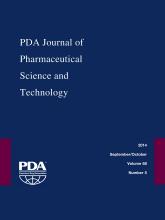Abstract
The inability to detect endotoxin using compendia methods is a potential safety concern for patients due to the lack of endotoxin removal capabilities at the fill–finish stage in typical aseptic biologic drug product manufacturing. We have successfully demonstrated endotoxin challenge study recovery methodology using mammalian cell–produced biologic drug products and drug substances in citrate, histidine, phosphate, and sodium acetate buffer formulations containing polysorbate, challenged with an endotoxin analyte, for up to 6 months of storage. Successful recovery was similarly demonstrated for a preserved, peptide-containing drug product formulation. To isolate a potential masking—or low-endotoxin recovery—source, additional studies were performed to evaluate factors including product manufacturing contact surfaces, drug product matrix with and without polysorbate, individual matrix components, protein concentration, reagent suppliers, an orthogonal test method, and storage conditions. In all cases, acceptable recoveries were observed. Bacterial endotoxin is known to be chemically stable at physiological conditions. Purified endotoxin in aqueous conditions is likely to self-aggregate or bind to surfaces. Neither the nature of, nor the storage conditions of, the studied formulation matrices were shown experimentally to render the challenge endotoxin biologically inactive. The results highlight the importance of appropriate study design in assessing the recovery of endotoxins.
LAY ABSTRACT: Bacterial endotoxin is a Gram-negative bacterial cell wall component that is harmful to humans at threshold concentrations, and it is not expected to be in aseptically-produced pharmaceutical medicines. It has been suggested that endotoxin cannot be detected over time in certain biopharmaceutical drug product formulations containing citrate, phosphate, and polysorbate components via an unknown masking mechanism. We have generated and present data here that indicate that endotoxin can be recovered in a variety of matrices, and under various experimental conditions.
- © PDA, Inc. 2014
PDA members receive access to all articles published in the current year and previous volume year. Institutional subscribers received access to all content. Log in below to receive access to this article if you are either of these.
If you are neither or you are a PDA member trying to access an article outside of your membership license, then you must purchase access to this article (below). If you do not have a username or password for JPST, you will be required to create an account prior to purchasing.
Full issue PDFs are for PDA members only.
Note to pda.org users
The PDA and PDA bookstore websites (www.pda.org and www.pda.org/bookstore) are separate websites from the PDA JPST website. When you first join PDA, your initial UserID and Password are sent to HighWirePress to create your PDA JPST account. Subsequent UserrID and Password changes required at the PDA websites will not pass on to PDA JPST and vice versa. If you forget your PDA JPST UserID and/or Password, you can request help to retrieve UserID and reset Password below.






